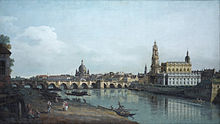Canaletto Blick
This article is an orphan, as no other articles link to it. Please introduce links to this page from related articles; try the Find link tool for suggestions. (April 2024) |


The Canaletto Blick (lit.: Canaletto View) of Vienna (Austria) is a famous perspective of the city center of Vienna, seen from the Upper Belvedere Palace. It was popularized by a painting from Bernardo Bellotto, known as Canaletto.
The Painting[edit]
The original painting, which serves as the blueprint for this view, depicts Vienna in the mid-18th century. The domes of Karlskirche, St. Stephen's Cathedral tower, and the dome of the Salesian Nuns' Church serve as vertical landmarks. The foreground shows the gardens of the Belvedere Palace. Other prominent landmarks visible in Bellotto's oil painting that still exist today are the Schwarzenberg Palace and the Lower Belvedere Palace.
Symbolism[edit]
This representation served not only as a faithful cityscape but also carried political symbolism. The painting reflects Vienna's development under the Habsburg dynasty. The artist embellished the perspective of his work, likely to please his patron, Maria Theresa. Buildings associated with the patroness were slightly enlarged or repositioned, notably the dome of the Salesian Nuns' Church, whose foundation stone was laid at the birth of Maria Theresa. The tower of the Elisabethinenkirche, shown on the far right of the image, would not have been visible from this vantage point, but Canaletto included it, likely due to financial support from the empress. Two observatories, no longer in existence today, were also depicted to honor the Habsburgs as patrons of the sciences.
Impact and protection[edit]
Despite Vienna's growth in the 19th century and the city's transformation from a fortified town, the overall impression of the Canaletto view remained largely intact and served as inspiration for numerous artists.
The Canaletto view has played a significant role in urban planning discussions, particularly in the debate over the construction of high-rises near Vienna's historical center. Plans to construct high-rises near Vienna's historical center have been a topic of discussion but are always tied to the protection of the Canaletto view. In 2017, UNESCO added Vienna to the watchlist after plans for a 75-meter-high-rise development (Heumarkt-Tower) within the confines of the cultural heritage site were approved. The World Heritage Committee ruled that the plans for the Heumarkt area threatened the characteristics that saw the city placed on the World Heritage List in 2001.[1][2][3][4]
Similar views[edit]

Bellotto's original painting is now housed in the Museum of Art History in Vienna. Another Canaletto view based on Bellotto's cityscape can be found in Dresden. This view from the right bank of the Elbe River below the Augustus Bridge also played a significant role in urban planning discussions, particularly in the debate over the reconstruction of Dresden's city center, heavily damaged by air raids in 1945.
External links[edit]
- Canaletto View in the Vienna History Wiki (in German)
- Vienna Cultural Heritage: Visual Relationships in the Cityscape (in German)
References[edit]
- ^ Feßler, Anne Katrin (2018-08-02). "Canaletto-Blick und das Weltkulturerbe: Wie mit Stadtansichten Politik gemacht wird". Der Standard. Retrieved 2024-04-21.
- ^ Gulnerits, Kathrin (2017-05-31). "Problemzone Heumarkt und der Turm des Anstoßes". News. Retrieved 2024-04-21.
- ^ Block, India (2017-11-22). "Isay Weinfeld high-rise puts Vienna UNESCO world heritage site under threat". Dezeen. Retrieved 2024-04-21.
- ^ Marits, Mirjam (2018-03-13). "Sichtachsen: Wie Wien den freien Blick schützt". Die Presse. Retrieved 2024-04-21.
This article needs additional or more specific categories. (April 2024) |
